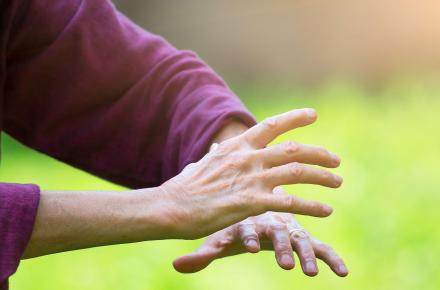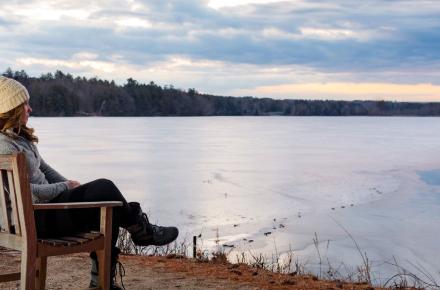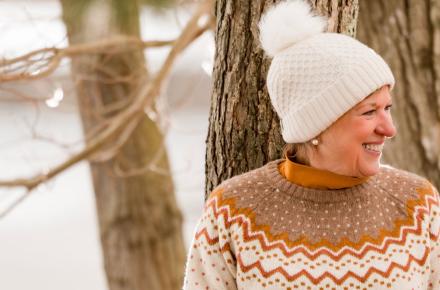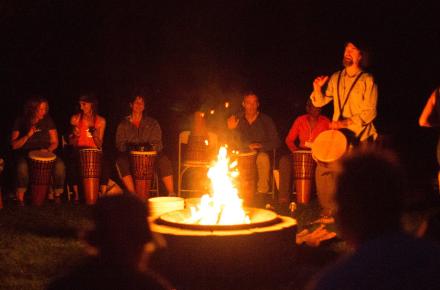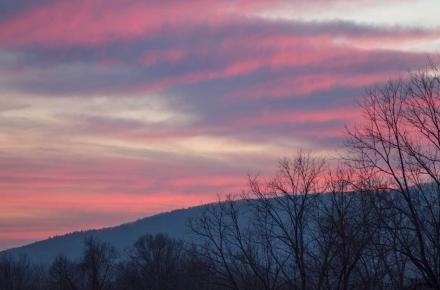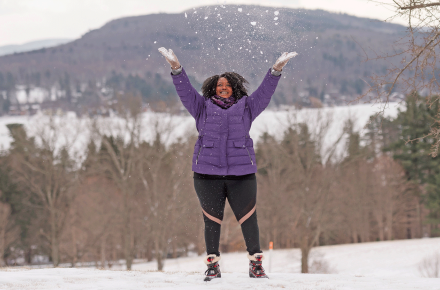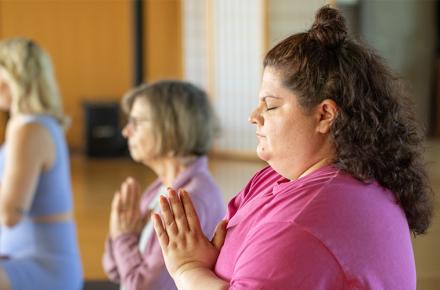Hike Happy with This Yoga Warm-Up Sequence

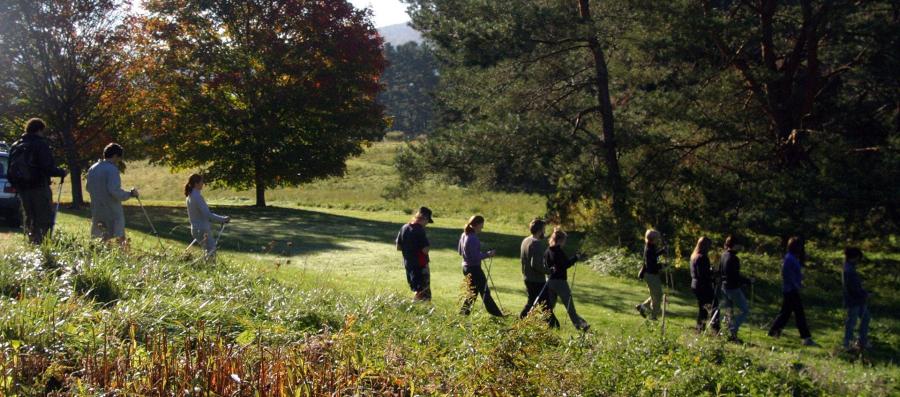
Hiking in the great outdoors is one of life’s most potent pleasures. Yoga can help enhance our hiking experience, preparing our muscles for exertion and supporting deeper awareness.
As you do the following warm-ups before a hike, pay attention to your body, your breath, and your mind. Notice the sensations that arise: Where are you feeling tight or sore? What parts of your body are feeling energized, ready to move? Cultivate a sense of awareness that you can take with you on every step of your hike.
These poses can be performed individually or as a flow. They can also be done dynamically (allowing for constant micromovements) or as static holds. Dynamic movement is best before your hike, as it warms up the muscles, while static holds serve you better post-hike, as they stretch and lengthen tired muscles.
Ankle rolls. Loosening the ankles is critical to avoid injury while hiking. To begin, stand with your feet hip-width apart and plant your feet on the earth. Shift your body weight into the left foot and slide your right foot, shoelace-side down, slightly behind you. Standing tall, begin to circle your ankle in one direction. Be sure to get over the shoelaces or tops of the foot. Do 10 to 15 rolls in each direction. Repeat on the other side.
Knee circles. Same idea as with the ankles. The knees are going to take the brunt of the action, especially if you are covering elevation, so lubricating the knee joints with deep, slow circles can protect them from impact. Stand with your feet together, bringing the big toes and knees to touch, and flex your ankles as deep as they will go without your heels coming up. Place your hands above your knees and do 10 to 15 circles in each direction.
Hip circles. This action lubricates your hip joints, which prevents tightness and helps move lymph. Stand with your hips shoulder-width apart. Place your hands on your hips and begin making circles; start small and gradually get bigger. Do 10 to15 circles in each direction.
Shoulder rolls. Shoulder rolls loosen the upper trapezius—especially important if you’re carrying a heavy pack on your hike. Stand with your hips shoulder-width apart and let your arms hang loosely. Begin rolling your shoulders forward and down 10 to 20 times, then reverse.
Twisting Lunge. This pose opens the front of the legs, the hips, the back, and the core—muscles that stabilize while traversing through awkward terrain. Begin with your feet hip-width apart. Step your right leg back and place your hands on either side of the front foot, coming into a low lunge. Lower the back knee down. Lower the top of your right foot down. Press your hips forward while maintaining a long spine. Drawing your shoulders away from your ears, press down through the right hand and reach your left arm overhead. Keep your shoulders stacked. Focus on twisting and lengthening your spine at the same time; this creates space and prevents compression. Hold for five to 10 breaths. Release the left hand down, step your right foot forward to meet your left, and slowly come up to stand. Repeat on the other side.
Chair pose. Chair pose is a great way to strengthen and warm up at the same time. Pulse your Chair to generate heat in the glutes and quads … you’ll need to engage both for those long uphill treks! Stand with your feet hip-width apart and bring your hands onto your hips. Focus on keeping your weight in your heels while you press your hips back as if sitting on a chair. From here, keeping your heels down and bring your arms up to shoulder height or overhead. Hold for five breaths.
Half Moon. This side bend warms up the lattisimus dorsi, the large, flat muscle behind your rib cage. Half Moon promotes blood flow and flexibility in your core, particularly helpful when hiking with a pack. Stand with your feet together and your hips facing forward. Stretch your arms overhead, interlace your fingers, and bend to the right, reaching as far as you can, mimicking the shape of the half moon. Repeat five to 10 times in each direction.
Tree. This pose stimulates your ankles while sharpening your attention, cultivating the balance you need to tackle those trails. Place your hands on your hips and stand tall. Begin to shift your weight onto your left foot. Lift your right leg and place the sole of your right foot on the inside of your left thigh, either below or above the knee. Keep your gaze steady on the ground. You can keep your hands on your hips, or you can press your palms together in front of your heart or reach your arms overhead. Take five deep breaths, then switch sides.
Dancer’s pose. Dancer’s pose opens the front of the legs and sharpens the mind, promoting balance. Stand with your feet hip-width apart and shift your weight onto your left foot, lifting your right leg off the ground. Bend your right knee and grab the outside edge of your right foot while lengthening the tailbone down. Kick your shin back into the right hand to feel a stretch in the front of the leg and tip your body forward, reaching your left arm out in front of you. Hold for five breaths, then repeat on the other side.
Downward-Facing Dog. This powerhouse pose warms up the shoulders and stretches the calves and the backs of the legs—particularly crucial for ascent. Begin in a tabletop position on your hands and knees. Align your shoulders over your wrists and your hips over your knees. Root your palms into the earth, spreading your fingertips wide. With bent knees, slowly lift your hips and lengthen your spine upward, coming into an inverted V shape. Keep your head and neck soft, and bring your gaze between your knees. Take five to 10 breaths. When you feel complete, come to rest in Child’s pose or on hands and knees, and repeat once or twice more.
Cobra. This backbend opens the front of body, as well as the front of the shins and ankles, all of which are important for hiking downhill. From a prone position, draw your hands directly under your shoulders and press the tops of your feet and your pubic bone into the ground. Press your hands down and lift your torso. Traction your shoulders down your back and reach the crown of your head toward the sky. Soften the tops of your shoulders. Gently tuck your chin to keep the back of the neck long. Relax your glutes and lower back. Take three to five breaths, then come down to rest. Repeat once or twice more.
Child’s pose. This restful stretch releases the lower back and calms the nervous system. From a tabletop position place the tops of your feet down and stretch your hips back toward your heels. Rest your forehead on the earth and stretch your arms out in front of you. Relax your neck. Take five to 10 breaths.
Pigeon. Pigeon rewards you with increased blood flow and flexibility in the legs and hip joints—areas that you will rely on most during long hikes. From a tabletop position, bring your right shin toward your left wrist and place your right knee down between your hands. Lengthen the left leg back until it is straight out behind you. Keep your hands on either side of the front knee, staying upright, or lay your head down on the ground—or your backpack—and reach your arms out as far forward as comfortable. Take five to 10 breaths on each side. If this pose is too intense, you can always practice Pigeon on your back, in a supine figure-four position.
Seated Spinal Twist. Twisting is vital for strengthening your core, which supports and stabilizes your body every step of the way, uphill and down. This is a slightly different twist from Twisted Lunge. From a comfortable seated position. Sit tall and place your right foot to the outside of the left leg. Bring your right hand behind you. Then place your left hand on the outside of your right knee and revolve your torso to the right. Take five to 10 breaths. Repeat on the other side.
Register for a Hiking and Yoga program at Kripalu.
© Kripalu Center for Yoga & Health. All rights reserved. To request permission to reprint, please email editor@kripalu.org.





























